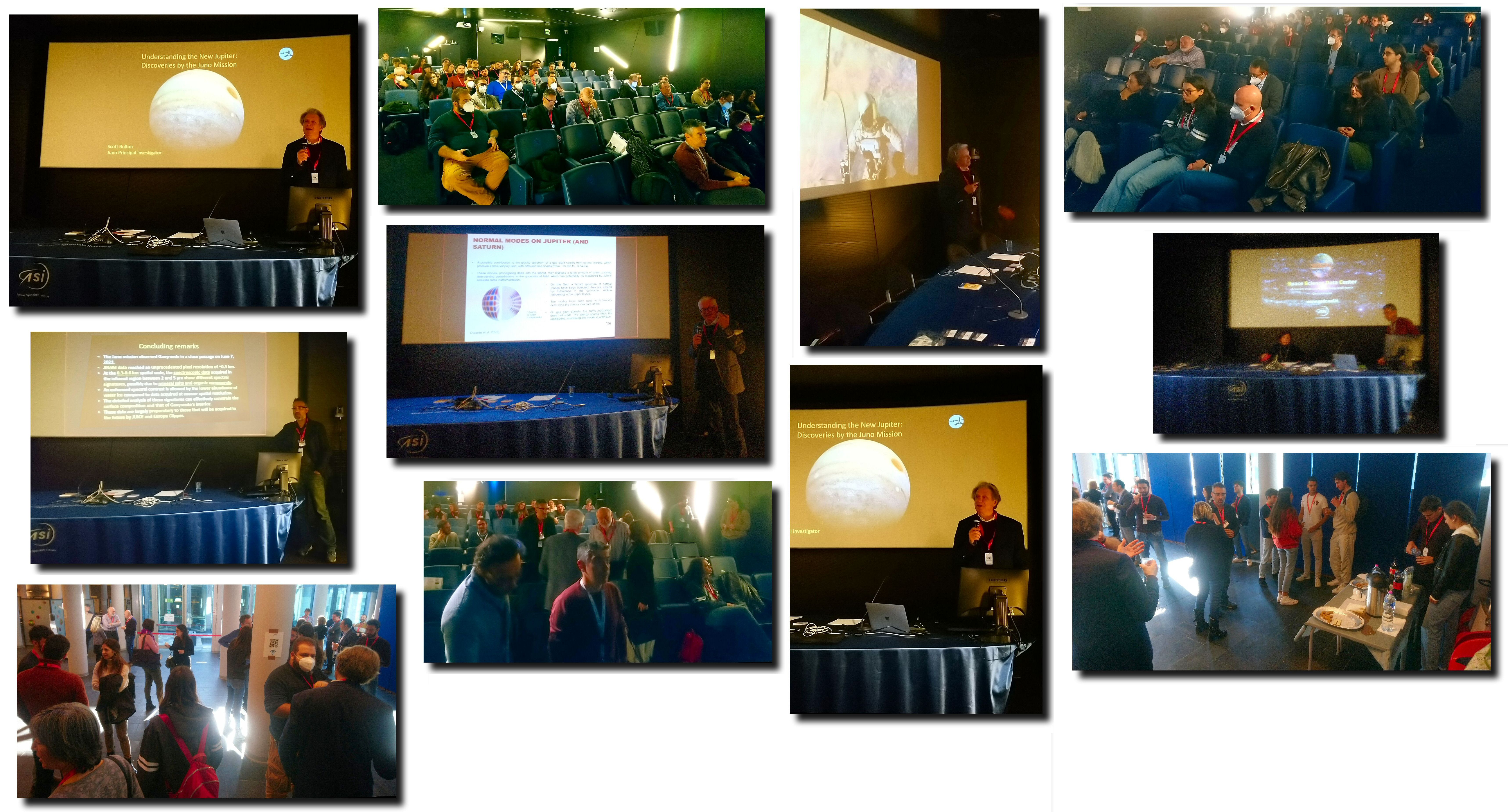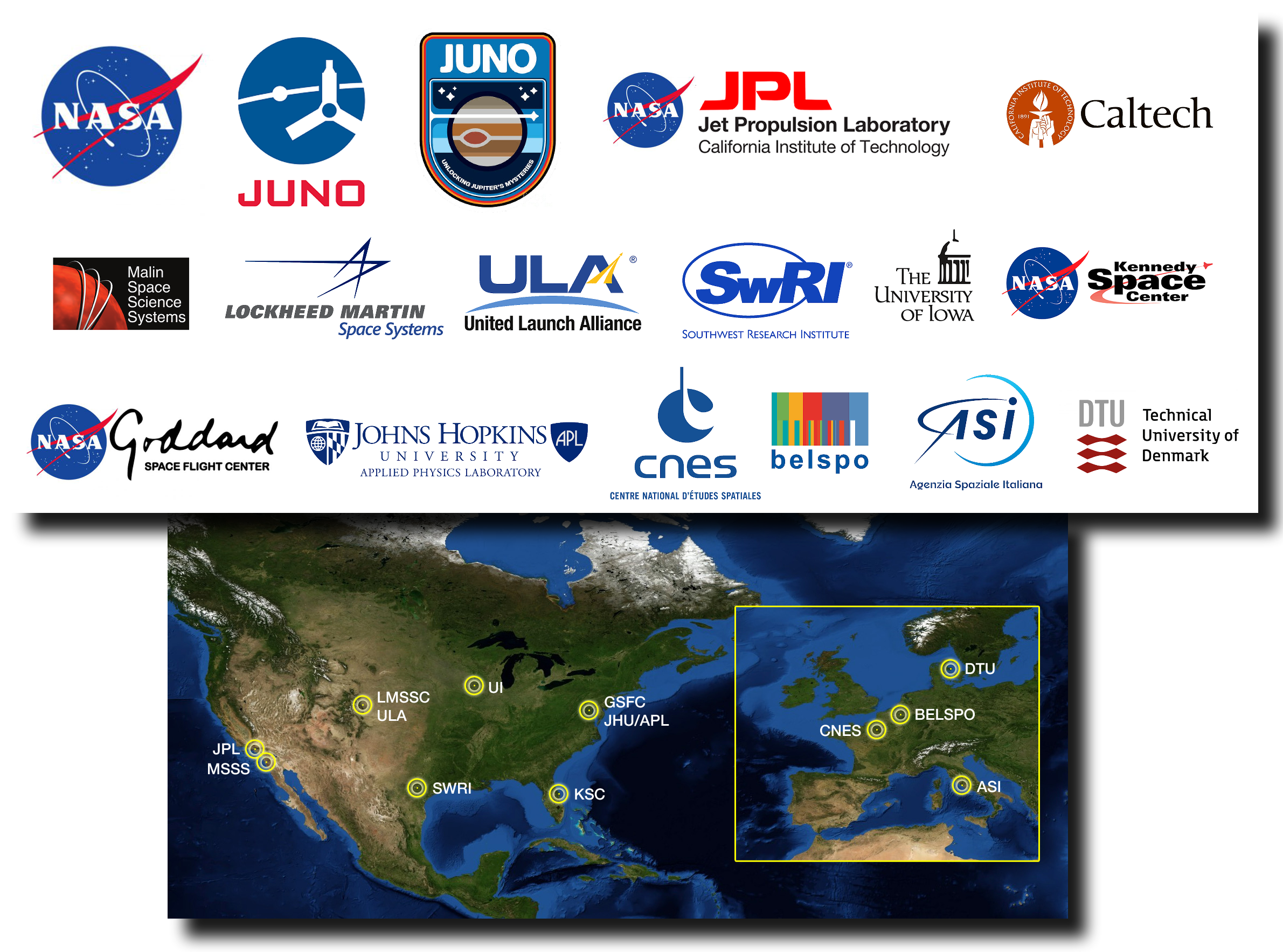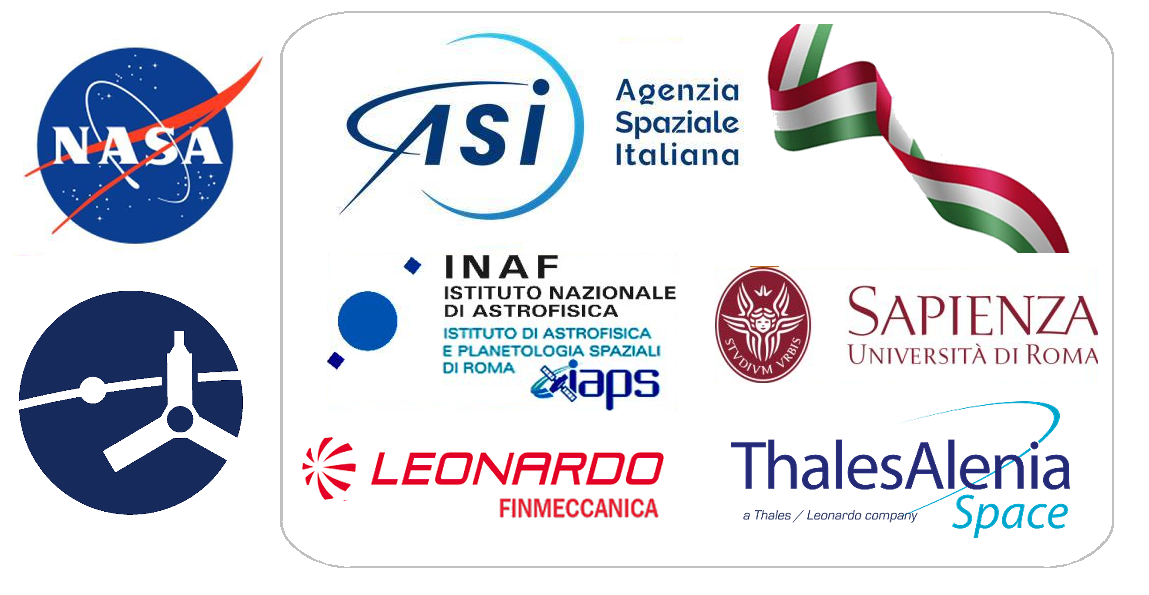Mini-workshop at ASI -The New Jupiter: Results from the Juno Mission
Sala CASSINI
Agenzia Spaziale Italiana

This, half a day, mini-workshop at the Agenzia Spaziale Italiana (ASI) headquarter in Rome, is dedicated to recap and highlight some of the results of the NASA Juno mission at Jupiter, with special guest Dr. Scott J. Bolton (Southwest Research Institute, SwRI). Here the main Juno mission web (at the SwRI).
This short (local Rome-area) event was announced by ASI, organized by the SSDC center in ASI (director G. Polenta) and by the INFN Rome Tor Vergata section (S. Ciprini, organizer of this event), with the collaboration of INAF IAPS (A. Mura) and the D.I.M.A of La Sapienza University of Rome (L. Iess).
Scott Bolton is Principal Investigator
of Juno and director of the Space Science and Engineering Division at the SwRI, after a 24 years of experience at NASA's Jet Propulsion Laboratory (JPL) with activity spanning a wide spectrum of management, engineering and scientific positions for planetary missions including Cassini, Galileo, Voyager and Magellan, to name a few.
Alessandro Mura (INAF IAPS, Rome) is local coordinator of the "Sun and Solar System" INAF group, and PI of the Italian JIRAM instrument, on board of Juno. Luciano Iess is professor of aerospace engineering at the Sapienza University of Rome, author of the most accurate measurement of General Relativity to date, and is the PI of the radio-instrument Ka-band Translator, on board of Juno.
The Juno mission is improving our understanding of the solar system's beginnings by revealing the origin and evolution of Jupiter, our solar system's largest planet, after more than six years and five months in orbit around this giant planet.
Lunched on Aug. 5, 2011, on board of an Atlas V 551 (AV-029) rocket, the solar-powered NASA Juno spacecraft (7,992 pounds, i.e. 3,625 kg mass, 20-meter wide) made its orbit insertion on Jupiter on July 5, 2016. Juno spacecraft is a dynamic engineering marvel, spinning to keep itself stable as it makes sweeping elliptical 53-day polar orbits around Jupiter. At their widest point, these carry Juno far from the giant planet and its moons, keeping it mostly clear of heavy radiation regions up to the outer reaches of the Jovian magnetosphere. But on closer passes, Juno cuts within 5,000 kilometers of Jupiter’s cloud tops.
It has a formidable array of science instruments:
Microwave Radiometer (MWR)
Gravity Science System (GS)
Vector Magnetometer (MAG)
Jovian auroral and plasma distributions experiment (JADE)
Jupiter energetic-particle detector instrument (JEDI)
Jovian infrared auroral mapper (JIRAM)
Ultraviolet Imager/Spectrometer (UVS)
Waves Radio/Plasma Sensors (Waves)
Imager in visible light with colors (JunoCam)
During the prime mission’s 35 orbits of Jupiter, Juno collected more than 3 Terabits of science data and provided dazzling views of Jupiter and its satellites, all processed by citizen scientists with NASA’s first-ever camera dedicated to public outreach.
Juno's many discoveries have changed our view of Jupiter's atmosphere and interior, revealing an atmospheric weather layer that extends far beyond its water clouds and a deep interior with a dilute heavy element core.
Among the top science discoveries of the primary mission, to cite only some of them, we find the following.
The previous Galileo spacecraft that dropped a probe into Jupiter’s atmosphere in 1995 found it unexpectedly dry. However Juno showed that nearer Jupiter’s equator, water is much more abundant.
Juno discovered a new, giant cyclone at Jupiter’s south pole, with a pattern of six cyclones. Juno picked up higher-frequency lightning resolving a 40-year-old conundrum. Jupiter's north pole is a strange, bluish region full of giant storms and strange weather. A central cyclone at Jupiter’s north pole is surrounded by eight more, ranging more than 4,000 kilometers.
Jupiter’s Great Red Spot has been swirling for centuries. But it appears to be slowly shrinking, from twice Earth’s size in 1979 to 1.3 times now. Juno plumbed the Great Red Spot’s depths, showing that its roots are 320 kilometers deep (100 times as deep as Earth’s oceans).
High-voltage electrical charges contribute to the formation of auroras at Jupiter’s poles, just as they do on Earth. But Jupiter is the solar system’s Texas: everything’s bigger.
The most powerful energies there come to 400 keV, while our most powerful auroras on Earth hit only a few thousand eV. Swarms of storms are shown in visible light (JunoCam imager), with clusters of swirling, Earth-size storms at both of Jupiter’s poles.
The cloud bands, or belts and zones, we can see from Earth's telescopes, have an intricate structure up close. Near the equator, they penetrate into the deepest parts of Jupiter’s atmosphere. But as you move closer to the poles, these belts tend to shapeshift into other structures.
Jupiter has an intense magnetic field. Juno showed it is far more intense than anyone expected, also bumpier. This field is 10 times stronger than Earth’s strongest.
Near the end of the prime mission, as the spacecraft’s orbit evolved, flybys of the moon Ganymede initiated Juno’s transition into a full Jovian system explorer. Now Juno in its extended mission (here the ASI news on the mission extension), and will continue its investigation of Jupiter through September 2025. This extension tasks Juno with becoming an explorer of the full Jovian system, Jupiter and its rings and moons,  with additional rendezvous planned for two of Jupiter’s most intriguing moons: Europa and Io.
with additional rendezvous planned for two of Jupiter’s most intriguing moons: Europa and Io.
Miscellanea (for the public):
- Juno web at the JPL.
- Juno mission web at the SwRI.
- Some videos on Juno mission and results.
- Scott Bolton on Juno (some videos).
- ASI news on the mission extension and the Italian collaboration.
Alberto Adriani
Alessandra Cofano
Alessandro Mura
Andrea Sesta
Angelo Zinzi
Antonio Caporale
Ariele Zurria
Barbara Negri
Chiara Castagnoli
Christina Plainaki
Cristina Baldetti
Daniele Durante
Davide Grassi
Federico Tosi
Flavia Giuliani
Francesca Altieri
Francesca Manni
Francesca Zambon
Francesco Biagiotti
Giacomo Fusco
Gianluca Polenta
Giovanni Valentini
Giulia Ceci
Giuseppe Sindoni
Irene Doria
Ivan di Stefano
Jaume Blanco
Livio Agostini
Luciano Iess
Marcel Snels
Maria Grazia Albanese
Marzia Trillo
Michael Plumaris
Michele Berretti
Paolo Racioppa
Pierpaolo Condò
Roberto Sordini
Scott Bolton
Stefano Ciprini
Umberto De Filippis
Valerio D'Elia
Veronica Camplone




